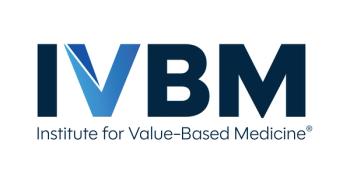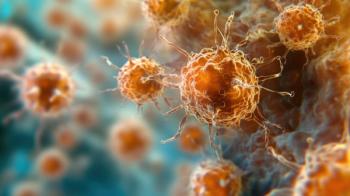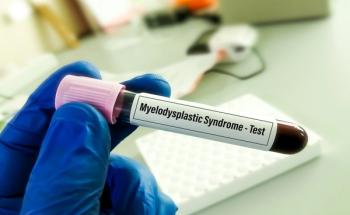
- October 2021
- Volume 27
- Issue 7
Building a Patient-Centered Cancer Center From the Ground Up
For generations, people in New Jersey who received a diagnosis of cancer spoke of “going into the city” for treatment.
In the northern counties, that meant New York City; further south, it meant a trip into Philadelphia. But over the past decade, the state with the fifth-highest rate of cancer incidence has invested in keeping patients closer to home, supported by evidence that travel not only exacts a toll on patients and affects outcomes, but it may also lead to longer hospital stays.1-8
Now, Rutgers Cancer Institute of New Jersey (CINJ), the state’s only National Cancer Institute–designated Comprehensive Center, is raising the stakes.9 On June 24, New Jersey Governor Phil Murphy and a “who’s who” of the state’s health care community seized the opportunity between the state surpassing a COVID-19 vaccination goal and dealing with the Delta variant to break ground on a $750 million, 12-story building, to be known as the Jack and Sheryl Morris Cancer Center.10 This new facility was borne of a partnership between Rutgers CINJ and RWJBarnabas Health, which operates 11 acute-care hospitals across a region that is home to 5 million people.11
This freestanding, dedicated cancer pavilion will offer medical, surgical, radiation, and immuno-oncology services in 1 location, giving clinicians, navigators, research staff , and support teams easy access to each another and, more importantly, to patients. The center is the mission of Steven K. Libutti, MD, FACS, who was named director of Rutgers CINJ in January 2017. Libutti also serves as vice chancellor for cancer programs at Rutgers Biomedical and Health Sciences and senior vice president for oncology services at RWJBarnabas Health.
With an aging population that is becoming increasingly diverse, Rutgers CINJ is well-positioned to serve more of the estimated 56,000 people diagnosed with cancer each year in New Jersey.1,12 In an interview, Libutti told Evidence-Based Oncology™ that according to projections, the cancer service line is increasing by 4% to 6% per year; the new center will be capable of handling up to 20,000 more cases per year. The number of staff available to assist patients in navigating care will be increased from 35 to 50 by the time the center opens in 2024, he said.
Libutti arrived after a period of transition following 2012 legislation that overhauled higher education governance and made the institute part of Rutgers University.13 At the time, restructuring was controversial, and some faculty left. Then part of the Robert Wood Johnson Medical School, CINJ already was producing world-class scientific results and collaborating with the state’s pharmaceutical sector on clinical trials.
Four years after Libutti’s arrival, predictions that reorganization could help make Rutgers CINJ a “powerhouse” appear to be coming true.3 Libutti has expanded the reach of the National Cancer Institute designation to cover the entire state as he has laid the groundwork for greater integration between the research and clinical programs and construction of a cancer center designed with patient experience as the focal point.13
Patient experience is not a buzzword. Consumers increasingly select where they receive care based on experience ratings and patient reviews, and CMS’ patient experience ratings also factor into reimbursement.14,15 Therefore, getting patients to stay in New Jersey for cancer care is not enough, Libutti said.
When a patient arrives at Rutgers CINJ, every phase of treatment—including survivorship care—should be delivered seamlessly, he said. All treatment soon will be offered under one roof, without the need to cross town or change services. A bridge will connect the existing cancer center and hospital to the new pavilion. The relationship with the state’s largest health system will mean better coordination during emergencies, he continued.
“Having an integrated oncology service line across the many hospitals and facilities of RWJBarnabas Health [will mean] that even if a patient needs that kind of additional care, such as a visit to an emergency room hopefully they’re no more than 15 or 20 minutes away,” he said. “And now, you’re showing up in an emergency room in New Jersey. As is often the case, when there’s a side effect, if it’s a Saturday or it’s 10 o’clock on a Friday night, tracking down your physician or your records at a distant place is a challenge.”
Doctors, Patients Give Input Into Design
Designed by HOK Healthcare, the Jack and Sheryl Morris Cancer Center will cover 510,000 square feet and have 84 infusion bays, which will increase capacity by one-third; the number of examination rooms will double to 74. There will be 96 inpatient beds on 3 floors, a dedicated floor for surgical and procedure rooms, wet-lab spaces for 10 research teams, and faculty offices.16 Advanced radiology services, diagnostic laboratories and equipment, a pharmacy, outpatient urgent care, and inpatient support spaces will be available in 1 location. Libutti is excited that existing services, such as a weekly tumor board that has met for years, will be able to better coordinate with other activities.
“The way I like to describe it is, rather than the patients going from doctor to doctor in a linear fashion, I think of the patient in the center of the lazy Susan [turntable] with all the physicians and necessary activities they have to undergo to get to a good diagnosis or to follow along during their care sort of circling around them,” he said. “And the patient is really the centerpiece of our care paradigm.”
Libutti worked closely with the developer, New Brunswick Development Corporation (DEVCO). Led by its president, Christopher J. Paladino, and its executive vice president, Sarah F. Clarke, DEVCO has reshaped the area in and around Rutgers’ New Brunswick campus, adding structures that include the honors college, New Brunswick’s performing arts center, and a hotel and conference center.17 The cancer center will stand out in the New Brunswick skyline and feature both indoor and outdoor common areas.
In an interview, Paladino said, “We’re really focused on making sure the public spaces are inviting, [that] they’re warm…as Dr Libutti described it, he wants the building to give everyone who walks in a virtual hug.”
The public might overlook the 25-foot-deep basement or the pavilion’s self-contained power plant, but these features will be achievements on their own. Clarke explained how sequencing will allow use of the garage to store materials as the tower is built. The deep basement will allow radiology services to be housed safely below ground; an earlier concept would have required above-ground concrete reinforcement. To avoid a feeling of darkness, the building will have a 4-story lobby that extends underground to allow natural light into the space.
Every project DEVCO completes offers insight into how people move through spaces, Paladino said. To design a cancer center, Libutti and the development team went straight to the sources as they conducted charettes that included physicians of different specialties, nurses, support staff, former patients, and caregivers. The groups initially received an early design overview from the architect, and then they went to work with markers and Post-It notes in hand.
“The natural thing was for this to turn into a ‘bitch’ session,” Paladino said, “but it very quickly became a ‘what if?’ session.” Paladino estimated that approximately 50 modifications came from this process, allowing the development team to catch problems early on. For example, Clarke has the gift of being able to identify materials that won’t last and finding aesthetically pleasing substitutes.
Paladino credits Libutti for his attention to the infusion center design, which went through multiple revisions until the team achieved the right balance of “privacy and openness.”
Paladino brings personal experience to this project. His wife was treated for breast cancer many years ago, and the atmosphere of an infusion center remains familiar. “You get used to seeing certain people on your schedule. There was some level of camaraderie.” But on other days, patients don’t want company; rather than hanging curtains to give patients privacy, the Rutgers team decided that half walls with glass doors that open and close would be built.
As the pavilion rises, the team that will work in the new center continues to grow. Several high-profile hires have been announced, including Missak Haigentz Jr, MD, as chief of thoracic medical oncology and of head and neck medical oncology and clinical director for oncology integration; the latter role involves promoting patient safety and efficiency and improving value-based care, including screening and preventive services.18
This integration will build upon what Libutti says is the center’s the team-based approach. “We have multidisciplinary teams focused on breast cancer, lung cancer, colon cancer, pancreas cancer, etc,” he said. “In terms of other specialists that are necessary in the context of caring for these patients, whether it be the appropriate diagnosis or providing supportive care, we have experts from a variety of disciplines, whether it be gastroenterologists, pathologists, or radiologists that all work together with our teams. That’s happening now and will continue to happen in the new cancer center.”
The Evidence for Staying Close to Home
From the groundbreaking to the visit with Libutti, the phrase repeated is, “Cancer doesn’t travel well.” The aim to keep patients “15 to 20 minutes” from home is not arbitrary. Some patients will still seek cancer management in medical centers with greater fame in New York City, even though the burdens of travel are being recognized in the literature.
Longer travel times to a cancer center also may pose unanticipated consequences for payers:
- For patients with pancreatic cancer, traveling more than 12.5 miles after surgery has been associated with worse overall survival.4
- Longer travel distance and insurance status helped determine which patients being treated for breast cancer were more likely to have contralateral prophylactic mastectomy; Black and Hispanic patients were at particular risk.5
- In a study of Medicare beneficiaries given a diagnosis of cancer, Medicare spending was 14% higher and patient cost responsibility was 10% greater among those traveling longer than 1 hour to a cancer center than for those having a travel time of 30 minutes or less.6 Shorter travel times were related to higher hospitalization rates in the initial management stage, whereas longer travel times were related to a greater likelihood of hospitalization at the end of life.
- Studies of patients with colorectal cancer and of surgery for prostate cancer found that longer travel times were associated with longer hospital stays.7,8
Libutti said the issue of what excess travel does to patients with cancer is an area ripe for further study. “First off, there’s the expense;…for chemotherapy or radiation therapy, these are multiple visits a week and, certainly, many times per month in terms of travel,” he said. “That’s an expense not only in dollar expense for the travel itself, but time away from family, time away from work—you have a support system that’s critically important as you’re going through a cancer diagnosis. And that support system is turned upside down or at least on its side when you have to get your care at a distance.”
The realization that some patients from New Jersey need to drive 2 hours each way to New York City for every cancer treatment became real for Paladino and his wife when a traffic accident turned their typical 40-minute ride from their home outside Princeton into a trek spanning more than 2 hours.
As they reached valet parking for the appointment, Paladino said, he recalled his wife saying, “‘Just imagine if we had to do that every time.’ And that really struck home with me.”
References
1. Cancer data and statistics. Centers for Disease Control and Prevention. June 8, 2021. Accessed September 27, 2021. https://www.cdc.gov/cancer/dcpc/data/index.htm
2. RWJBarnabas Health and Rutgers Cancer Institute of New Jersey announce new $750 million state-of-the art freestanding cancer pavilion in New Brunswick. News release. June 3, 2019. Accessed September 27, 2021. https://bit.ly/3m5kdo8
3. Gov. Christie signs higher education restructuring bill. News12 New Jersey. August 22, 2018. Accessed September 30, 2021. https://newjersey.news12.com/gov-christie-signs-higher-education-restructuring-bill-34868881
4. Siegel J, Engelhardt KE, Hornor MA, Morgan KA, Lancaster WP. Travel distance and its interaction with patient and hospital factors in pancreas cancer care. Am J Surg. 2021;21(4):819-825. doi:10.1016/j.amjsurg.2020.08.023
5. Ward EP, Unkart JT, Bryant A, Murphy J, Blair SL. Influence of distance to hospital and insurance status on the rates of contralateral prophylactic mastectomy, a National Cancer Data Base study. Ann Surg Oncol. 2017;24:3038-3047. doi:10.1245/s10434-017-5985-1
6. Rocque GB, Williams CP, Miller HD, et al. Impact of travel time on health care costs and resource use by phase of care for older patients with cancer. J Clin Oncol. 2019;37(22):1935-1945. doi:10.1200/JCO.19.00175
7. Spaulding AC, Borkar S, Osagiede O, et al. Impact of travel distance on quality outcomes in colorectal cancer. Am J Manag Care. 2020;26(11):e347-e354. doi:10.37765/ajmc.2020.88529
8. Olson DJ, Gore JL, Daratha KB, Roberts KP. Travel burden and the direct medical costs of urologic surgery. J Health Econ Outcomes Res. 2016; 4(1);47-54. doi:10.36469/9825.
9. Rutgers Cancer Institute of New Jersey. National Cancer Institute. Updated February 10, 2021. Accessed September 28, 2021. https://www.cancer.gov/research/infrastructure/cancer-centers/find/cinj
10. NJ COVID latest: Thursday, June 24, 2021. PIX 11. June 24, 2021. Accessed September 30, 2021. https://pix11.com/news/coronavirus/nj-covidlatest-thursday-june-24-2021/
11. RWJ Barnabas Health and Rutgers Cancer Institute of New Jersey break ground on Jack & Sheryl Morris Cancer Center. News release. Rutgers Cancer Institute of New Jersey. June 24, 2021. Accessed September 26, 2021. https://bit.ly/39HXSHA
12. Evans T. Census 2020: New Jersey’s older and increasingly diverse centers are now leading the state’s population growth. New Jersey Future. September 13, 2021. Accessed September 26, 2021. https://bit.ly/3F0GHPS
13. Goldberg P. Libutti: how Rutgers Cancer Institute became a New Jersey-sized colossus. The Cancer Letter. May 17, 2019. Accessed September 27, 2021. https://bit.ly/3EYnDll
14. 2021 Healthcare Reputation report correlates strong reputation score with higher patient conversions on Google. News release. Reputation. March 4, 2021. Accessed September 27, 2021. https://bit.ly/2ZzQhsF
15. Detwiler K, Vaughn N. Patient satisfaction and HCAHPS reimbursement. Relias. September 11, 2020. Accessed September 28, 2021. https://www.relias.com/blog/how-do-patient-satisfaction-scores-affect-reimbursement
16. RWJBarnabas Health and Rutgers Cancer Institute of New Jersey unveil plans for new cancer pavilion. News release. HOK Healthcare. October 28, 2020. Accessed September 27, 2021. https://www.hok.com/news/2020-10/rwjbarnabas-health-and-rutgers-cancer-institute-ofnew-jersey-unveil-plans-for-new-cancer-pavilion/
17. About us. New Brunswick Development Corporation. Accessed September 27, 2021. https://devco.org/page/2/about-us
18. New chief of thoracic and head and neck medical oncology named to New Jersey’s only NCI designated comprehensive cancer center. News release. Rutgers Cancer Institute of New Jersey. September 1, 2021. Accessed September 27, 2021. https://www.cinj.org/new-chief-thoracic-and-headand-neck-medical-oncology-named-new-jerseys-only-nci-designated
Articles in this issue
over 4 years ago
From the Editor-in-Chief: The Way Upover 4 years ago
The Promise of Liquid Biopsies for Cancer DiagnosisNewsletter
Stay ahead of policy, cost, and value—subscribe to AJMC for expert insights at the intersection of clinical care and health economics.





























































